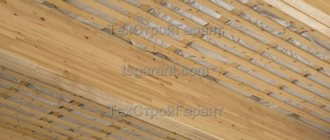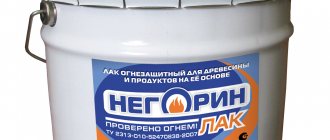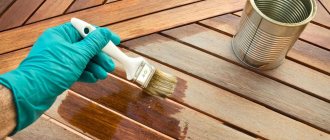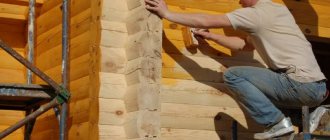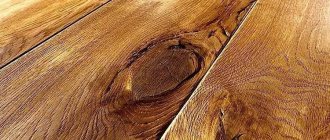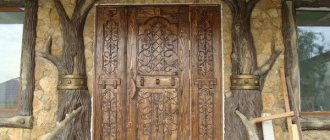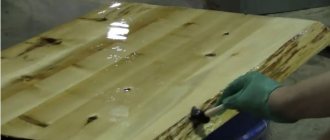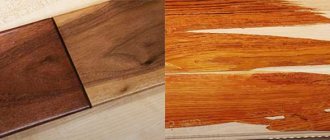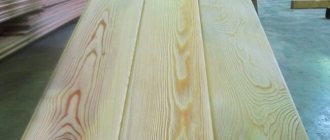A two-story wooden house 10x10 meters needs just 10 minutes, so that the flame completely engulfs the entire floor and 120 minutes for the building to burn to the ground. The temperature during a fire, on average, ranges from 500°C to 900°C, and the rate of spread in most cases is 8-12 m2/min, so any fire, even a minor one, poses a huge danger to the people living in it.
We would like to present to you the 50 most effective fire safety measures in a private wooden house. And if you think that we will tell you obvious things about fire safety that you already know about, you are mistaken! Many of the tips, despite their obviousness, did not even occur to you. Read and make sure that at least a couple, or even a dozen items could be organized for your home for the safety of you and your family.
How does fire protection work?
Protecting wood from fire is possible in two ways:
- Fire retardants, which contain fusible substances (salts of silicic, boric or phosphoric acid), melt when heated, forming a resistant film that does not allow air to pass to the wooden surface. Thanks to this, the ignition temperature of wood significantly increases, and therefore its fire resistance.
- If the fire-fighting mixture contains ammonia or other similar preparations, then during a fire they release gases that suppress the flame and push oxygen away from the surface of the wood.
Types of mixtures
All compositions, depending on the base, can be divided into:
- Paints. They provide good protection by covering wood products with a dense and durable film. Cons: hide the beauty of the surface; toxic. It is good to use them for fireproof protection of old buildings.
- Lucky. They highlight the beauty of a wooden surface and reliably protect it from fire, but due to toxicity they are not suitable for interior work.
- Impregnations are the most commonly used.
We need to dwell on the latter in more detail. Impregnations perfectly preserve the structure of wood, penetrate deeply into the material, protecting it from fire.
Depending on the solvent there may be:
- organosoluble - often toxic, used for outdoor use.
- water-soluble - non-toxic, suitable for treating walls inside and outside.
Water-soluble impregnations are divided into:
- Easily washable. They are used in dry and moderately damp interior spaces, are well suited for living rooms, and provide good protection in case of fire.
- Washable. Used to treat living rooms and utility rooms with moderate humidity, they protect wood well from fire.
- Difficult to wash out. Suitable for wet areas (kitchen, bathroom) and for outdoor use.
- Non-washable compounds with increased fire retardant function. Well suited for external and internal treatment of baths, saunas and other fire-hazardous objects.
Low-cost fire protection measures
- Install a fire protection RCD - a protective shutdown device. The electrical panel of a private house must be equipped with an RCD; it is not that expensive. Even better, install a differential circuit breaker, it will also protect you from short circuits and overloads in the system. An RCD must also be installed in the house - after the meter, to protect the network.
- Install smoke detectors and fire alarms. Normally functioning sensors reduce the risk of fire by more than 50%. Installation is necessary in every room, on every flight of stairs, in the boiler room, bathhouse, garage...
- Do not use flammable insulation materials during construction.
- Do not forget to carry out regular maintenance of heating equipment - at least once every six months. If you used materials not in accordance with SNIP, then check and replace equipment elements - pipes and so on - even more often. From personal experience: our neighbors installed an asbestos pipe in their boiler room instead of a more reliable one, because they wanted to save money. The result is a completely burned house. The tragic mistake of not wanting to carry out maintenance and repairs in a timely manner.
- Install large address signs, clearly visible from the road, on the walls of the house: the higher, the better.
- Install large, highly visible address signs at the entrance to your home. Use non-flammable materials.
- Install metal screens in all attics, around the perimeter of the foundation, and in all places where fallen leaves and pine needles may accumulate.
- Install fire extinguishers in the house, always in the kitchen and garage, at least one per floor.
- Install a metal shield between the wall of the house and the adjacent wooden fence.
- Replace evergreen shrubs with less flammable plants near your home.
- Clear dry branches and trim coniferous plants around the house.
- Buy a weather warning radio and use it to know about an emergency in time.
- Replace vinyl gutters and downspouts with similar ones made from fire-resistant materials.
- Install spark arrestors or heavy metal screens on all fireplaces and chimneys.
Processing methods
Impregnation of wooden fire protection products can be of different depths:
- Superficial. As a rule, it is carried out on already completed objects. The composition is applied to a well-cleaned and degreased surface using a brush, roller or spray, left until dry, and then the rest of the decorative work on wood is carried out. Fire retardant ability is moderate.
- Moderate. It is carried out by soaking in special baths, and is carried out during the construction process. Provides the building with good fire protection.
- Deep, using an autoclave. Such impregnation is only possible industrially, when the composition under pressure is driven deep into the pores of the wood. The resulting board has high fire-bioprotective qualities and does not require subsequent treatment with protective agents.
When choosing a method and solution for treatment, it should be borne in mind that the deeper the composition penetrates into the base of the tree, the higher its resistance to fire will be. If it is possible to use autoclaved wood for construction, then it is better to build from it.
Free fire prevention measures
- Perform a fire safety assessment of your home, at least visually.
- Keep firewood a safe distance from your home.
- Regularly clear the roof and gutters of leaves and pine needles.
- Make sure the house address sign is clearly visible from the road.
- Attach a long hose to the faucet in the yard and run it to the house.
- Trim all tree branches that overhang the roof of the house.
- Trim all tree branches that are closer than half a meter to chimneys.
- Remove trees along your home's driveway.
- Trim tree branches that overhang your driveway.
- Surround the house with a green lawn with a radius of at least 10 meters, if space allows.
- If new home construction is ongoing in your area, speak with the developer and local authority to ensure construction is carried out to fire safety standards.
- Develop and discuss a fire escape plan with your family. Conduct exercises, including with the participation of pets.
- Check your fire extinguishers. Are they charged? Are they easily accessible? Does everyone in the family know how to use them?
- Remove dead wood and flammable vegetation near your home.
- Remove any evergreen shrubs growing near your home, especially if you live in a wildfire risk area. They burn just fine.
- Get home insurance (it's not as expensive per year as you think) or review your home insurance to make sure it will adequately cover damage in the event of a fire. Consult with construction companies to find out the cost of rebuilding and renovating homes in your area. The presence of an insurance policy for property did not leave any cautious family homeless who managed to take care of property protection in time.
- Talk to your children about the dangers of playing with fire.
- If you burn garbage in a designated barrel, stop doing it.
- Collect fallen leaves into compost piles rather than burning them.
- Do not burn the grass on your property, this can have serious consequences.
- Always keep a shovel and a garden hose connected to a water faucet handy when burning anything in your yard.
- Never light a fire in your yard if the wind is blowing toward your house or your neighbor's house.
- Do not forget to check the functionality of smoke detectors at least once a year, and check the expiration date of fire extinguishers.
- Unplug ALL electrical appliances from sockets if you need to leave and there is no one in the house, or before going to bed. Seriously, check the outlets before you go out, it's really easy and quick. It is also necessary to replace cracked or damaged wires.d
- We don’t think it’s worth reminding us of the consequences of smoking in bed, uncontrolled burning of candles, especially under a wooden roof, and how often Christmas trees light up when a garland of lights is shorted out.
- Carefully read the rules for operating gas and heating equipment, stoves, and fireplaces. Using a tape measure, measure whether your fireplace or chimney is installed at the correct distance. Do not look at the fact that the installation company is experienced and professional. Fire safety violations are found everywhere.
- No curtains, textiles, or carpets should be very close to heating appliances or fireplaces; keep a safe distance.
Degrees of protection
According to fire safety standards, the degree of protection of wood from fire can be:
- Maximum, first class. Such fire and bioprotection is inherent in wood after autoclave treatment. Buildings made of such material can not catch fire under the influence of fire for up to 150 minutes.
- Average, second grade. The treated wood becomes highly flammable and can resist flames for up to 90 minutes. This stability is achieved by soaking the boards before construction in a bath with a fire retardant compound.
- Low, third class. This is achieved by surface treatment of buildings with solutions, typical for private residential buildings.
Projects of wooden houses with a terrace or veranda
Number of projects 1602
- 4 rooms
- 3 bathrooms
House Project HPL-0020-N00xx-0192
To favorites
192² Total area
from 4,348,800 rub. Construction time individually
- 3 rooms
- 1 bathroom
Robin Hood House Project
To favorites
- 136² Total area
- 9 x 9m Construction area
from 1,581,300 rub. Construction time individually
- 5 rooms
- 2 bathrooms
House project "4516"
To favorites
- 158.4² Total area
- 10 x 11m Construction area
from RUB 1,645,350 Construction period 30 days
- 2 rooms
- 2 bathrooms
Project of the Ulyana House
To favorites
- 83.4² Total area
- 10 x 7m Construction area
from 2,241,000 rub. Construction time individually
- 1 room
- 1 bathroom
Project Country House “Lucky Minimum”
To favorites
- 30² Total area
- 5 x 6m Construction area
from 540 150 rub. Construction time 4 days
- 2 rooms
- 1 bathroom
LATO-50 DIY House Project
To favorites
- 50² Total area
- 6 x 7m Construction area
from RUR 1,444,396 Construction time individually
- 6 rooms
- 2 bathrooms
Lark House Project
To favorites
- 126² Total area
- 7 x 9m Construction area
from 1,612,000 rub. Construction time individually
User selection
- 4 rooms
- 2 bathrooms
Gennadich House Project
To favorites
- 122² Total area
- 8 x 8m Construction area
from 2,490,000 rub. Construction period 60 days
- 4 rooms
- 2 bathrooms
House project designed by architect. M.A.Kuzmina (1877)
To favorites
- 342² Total area
- 10 x 11m Construction area
from 4,617,000 rub. Construction period 164 days
- 4 rooms
- 2 bathrooms
Esquire Mini House Project
To favorites
- 140² Total area
- 8 x 10m Construction area
from 2,165,400 rub. Construction time individually
- 6 rooms
- 2 bathrooms
Kotlas House Project
To favorites
- 269² Total area
- 16 x 14m Construction area
from 2,696,000 rub. Construction time individually
- 3 rooms
- 1 bathroom
Project of the Perspective House (one-story)
To favorites
- 111² Total area
- 11 x 8m Construction area
from 1,498,500 rub. Construction period 59 days
- 1 room
- 1 bathroom
Bathhouse Laskovaya project
To favorites
- 50.95² Total area
- 9 x 7m Construction area
from RUB 687,825 Construction period 35 days
- 2 rooms
- 1 bathroom
Project House made of timber SR-138
To favorites
- 75² Total area
- 9 x 9m Construction area
from 1,012,500 rub. Construction period 90 days
- 5 rooms
- 2 bathrooms
Konstantinovo House Project
To favorites
- 168² Total area
- 13 x 8m Construction area
from 2,268,000 rub. Construction period 85 days
- 8 rooms
- 2 bathrooms
Anna House Project
To favorites
- 293.4² Total area
- 15 x 12m Construction area
from 7,325,000 rub. Construction time individually
1 room
Summer house project “Summer Day”
To favorites
- 27² Total area
- 6 x 5m Construction area
from RUB 333,450 Construction time individually
Available at the exhibition
1 bathroom
Bath Chalet Project
To favorites
- 54² Total area
- 6 x 7m Construction area
from 660,000 rub. Construction period 20 days
- 5 rooms
- 3 bathrooms
House Project FD-40-1-276
To favorites
- 276.07² Total area
- 16 x 12m Construction area
from 4,421,030 rub. Construction time individually
- 4 rooms
- 2 bathrooms
Veles-1 House Project
To favorites
- 97² Total area
- 7 x 7m Construction area
from 1,309,500 rub. Construction period 52 days
View all projects
To choose the right product, you need to study its composition and properties Source elka-palka.ru
Self-protection of a building from fire
Unfortunately, it is impossible to give a finished structure first and second class fire protection to wood. But the composition chosen depending on the purpose will help to significantly reduce the fire hazard. When choosing impregnation, you must consider:
- Heating of the room. For attics, verandas, as well as for exterior work, frost-resistant compounds must be used.
- Influence of atmospheric factors. For the street you need mixtures that are difficult to wash out.
- Environmental friendliness. Only non-toxic preparations are suitable for residential premises, and when working with toxic ones it is necessary to use protective equipment.
- Aesthetics. As a rule, impregnating agents do not affect the color or texture of wood in any way.
- Economical.
- Fire safety. The instructions for use must indicate the protective degree of the drug.
- Sustainability. How long should it take before further processing?
Applying fire retardants to a wooden surface is not difficult. It is carried out in the same way as when using other types of impregnation:
- All impregnation work is carried out at above-zero temperatures in calm weather or in a well-ventilated area. Working at sub-zero temperatures will reduce the absorbent qualities of the wood surface and reduce the protective properties of the solution.
- The boards are cleaned of old paint, dirt and dust.
- If possible, degrease with white spirit.
- The solution is evenly applied to the prepared area using a brush, roller or spray gun.
- The surface is dried and final decorative and construction work is carried out.
Advice: you can check the fireproof qualities of the treatment yourself. To do this, you need to take small slivers from different places in the wooden structure and hold them over the flame.
Without constant exposure to fire, the chip should go out. Carrying out fire retardant impregnation of buildings is a responsible process that should not be neglected during construction or cosmetic repairs.
Proper application of fire retardants to wooden surfaces will increase the safety of your home. But it is worth remembering that even the highest quality preparations applied superficially, after a couple of years under the influence of atmospheric phenomena, reduce their protective properties. They will need to be reapplied.
Remover for cuticles and corns
A special cuticle product makes it easier to remove without cutting and significantly speeds up the process. The remover for corns allows you to do a pedicure without soaking your feet, and also gets rid of unpleasant dust.
Removers are sold in the form of gels, creams and liquids. According to reviews, the cream is considered the most convenient to use, while the gel is easier to apply evenly and accurately. As for the liquid, it can leak and cause a chemical burn.
Give preference to bottles and tubes with special spouts that allow you to accurately apply the product. Working with a brush will require some experience.
The price of different types of removers is affected by their performance, composition and volume. After using cheap products, you often have to cut off the remaining cuticle.
- Alkaline preparations are highly effective and fast-acting - the procedure takes from 1 to 3 minutes. In no case should you exceed the specified time, so as not to damage the nail plate and get burned.
- Suspensions or liquids based on aggressive acid are professional salon products. Excellent for removing corns.
- Removers based on fruit acids are the most popular and safe. Their range is quite large, differs in cost and efficiency. Disadvantage: long exposure process.
